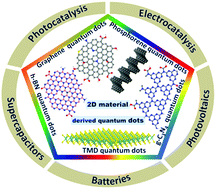Quantum dots derived from two-dimensional materials and their applications for catalysis and energy
Abstract
Quantum dots (QDs) derived from the atomically-thin two-dimensional (2D) sheets (graphene, transition metal dichalcogenide, graphitic carbon nitride, hexagonal boron nitride, and phosphorene) are emerging extraordinary zero-dimensional materials. Covering a broad spectrum of interesting optical, catalytic, electronic, chemical and electrochemical properties, these 2D-QDs promise a wide range of novel applications including imaging, sensing, cancer therapy, optoelectronics, display, catalysis, and energy. In this article, we discuss the synthesis methods and the properties of these 2D-QDs and emphasize their applications in electrocatalysis, photocatalysis, supercapacitors, batteries, and photovoltaics.


 Please wait while we load your content...
Please wait while we load your content...